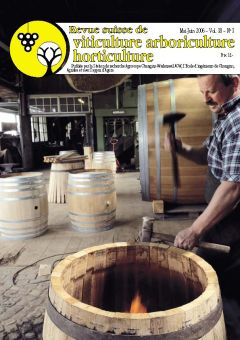
Issue 3 - May - June 2006
Abstract in open access
Toasting of oak barrels has been studied in a Swiss artisanal cooperage using Swiss oak staves of well-defined botanical species, geographical origin and seasoning duration. Practical rules allowing a good reproducibility of the toasting process are given. A simple tool was built up to provide a quantitative description of the toasting process. The destructive effect of toasting on ellagitannins, but also on a few undesirable chemicals in staves, was assessed, the latter showing that a careful selection of head staves may avoid toasting them for security grounds only. Toasting starts by an accumulation of xylovolatile compounds, followed by a modification of their global aromatic pattern. Treatment of experimental data by principal component analysis showed that the various oak origins could be discriminated in both barrels and their corresponding wines, at any toasting duration. Similar conclusions are drawn from sensory analysis, provided that adequate tasting criteria are used.
Keywords: artisanal cooperage, Swiss oak, barrel toasting, origin discrimination
E-Mail: andre.rawyler@eichangins.ch
Adress:
Abstract in open access
The influence of canopy management factors, such as inter-row distances and height of hedge foliage, on vine water status (cv. Chasselas) was studied from 1996 to 1998 on the experimental estate of the Agroscope Changins-Wädenswil at Leytron (Wallis, Switzerland). Training systems which have a high surface area of exposed foliage (low inter-row spacing and foliage of significant height) developed greater water stress than systems with smaller areas of exposed foliage during periods of extreme climatic conditions and drought. In addition, in vines with large plant volumes, a reduction in gaseous exchanges (photosynthesis and leaf transpiration) was observed.
Keywords: inter-row distance, surface area of exposed foliage, water status
E-Mail: vivian.zufferey@acw.admin.ch
Adress:
Abstract in open access
The mating disruption technique to control grape berry moth Eupoecilia ambiguella and grape vine moth Lobesia botrana, was applied by means of RAK1+2, Bocep Viti, RAK1+2R, or Isonet-LE dispensers, from 1997 until 2005 on the 165 ha vineyard of Yvorne. Many difficulties appeared during the first years, due to a high initial population, a late installation of the dispensers, a too short duration of pheromone emission, an insufficient density of dispensers per ha or a change of the pest’s dominance related to climatic conditions. Complementary insecticidal treatments in first or second generation proved to be necessary on a more or less large surface according to the seasons. Eventually, in 2004 and 2005, any recourse to insecticides could be avoided and the populations of pest broke down. During these nine years, the level of damage, which strongly fluctuated, was always lower at Yvorne than in the vineyard of Aigle nearby, under classical control with insecticides.
Keywords: grape berry moth, Eupoecilia ambiguella, grapevine moth Lobesia botrana, mating disruption, dispensers, population density
E-Mail: pierre-joseph.charmillot@acw.admin.ch
Adress:
Abstract in open access
Plantlets type of and planting date are important factors to express agronomic potential of a strawberry cultivar and to get a successful crop. The trials made by Agroscope Changins- Wädenswil ACW showed that cultivars Clery, Darselect and Madeleine had higher and earlier yields with plug plantlets than with frigo ones. The planting date had a less influence on yield and precocity. However, planting frigo plantlets after 15th of July and plug plantlets after 10th of August considerably reduced the yield.
Keywords: Fragaria × ananassa, strawberry, frigo plantlets, plug plantlets
E-Mail: andre.ancay@acw.admin.ch
Adress:
Abstract in open access
The currant clearwing moth (Synanthedon tipuliformis Clerck), a Lepidoptera species of the family of the Sesiidae, is a serious pest of both red and black currant. Mating disruption to control S. tipuliformis was tested on red currant from 2002 to 2005 in the cantons of Thurgau and Geneva. In the treated plots, catches of adult male moths in the pheromone traps were strongly reduced. The results of these two trials showed a good efficacy of the mating disruption with 600 «Isonet-Z» dispensers per hectare to control this pest.
Keywords: currant clearwing, mating disruption, pheromone, red currant, Synanthedon tipuliformis
E-Mail: catherine.baroffio@acw.admin.ch
Adress:
Abstract in open access
From 2001 to 2003, the incidence of the phenological stage on the quality of floral trusses by white genepi (Artemisia umbelliformis Lam.) was precisely defined. The ideal period for a maximal content of essential oil and costunolide (bitter principle) is the beginning of flowering. After this stage, the essential oil and costunolide contents drop of about 50%. Nevertheless, the chemical composition of the essential oil remains stable during the whole flowering period of white genepi. The rosette leaves show a chemical composition of the essential oil similar to the one of the floral trusses and could probably be valorised at the end of the culture. The optimal harvesting stage is being discussed.
Keywords: Artemisia umbelliformis, costunolide, essential oil, flowering, harvest stage
E-Mail: xavier.simonnet@acw.admin.ch
Adress:

 Download of full issue
Download of full issue
 Download article
Download article